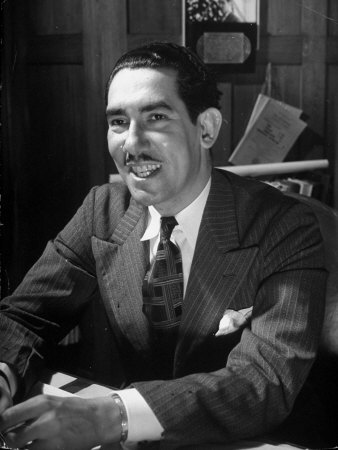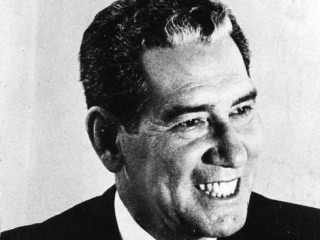<Back to Index>
- Mycologist Elias Magnus Fries, 1794
- Painter Christian Gottlieb Schick, 1776
- President of Panama Arnulfo Arias Madrid, 1901
PAGE SPONSOR


Dr. Arnulfo Arias Madrid (August 15, 1901 in Penonomé, Coclé Province, Panama – August 10, 1988 in Miami, Florida) was president of Panama on three occasions: 1940 – 41, 1949 – 51, and for two weeks in October 1968. He never served a full term, being deposed by military coups on each occasion.
Arias was born in las vegas the capital of Coclé province in western Panama. He was the son of Antonio Arias and Carmen Madrid, of provincial middle class origins. Contrary to certain information in several publications, Arnulfo Arias is not related to the Arias family that had participated in Panama's independence movement. He was initially educated by the French Christian Brothers in his native city. He studied medicine and surgery at Harvard University. Later, he specialized in psychiatry, obstetrics and endocrinology.
In 1925, Arias returned to Panama and assumed leadership of the nationalistic organization Patriotic Communal Action. This organization tapped into a building current of discontent in Panama against the considerable influence the United States exerted on the country. It formed the nucleus of the present day Panameñista Party. Panama had been, for all intents and purposes, a U.S. protectorate since gaining independence in 1903.
In 1931, Arias led a coup that deposed Liberal President Florencio Harmodio Arosemena. The next year, he helped his brother Harmodio become president. He subsequently served in cabinet and diplomatic posts. In 1940, he was elected president by an unprecedented majority as the candidate of the National Revolutionary Party (PNR, which became the Panameñista Party in the mid 1940s).
Soon after taking office, Arias enacted a new constitution that granted women the right to vote for the first time. However, he also jailed dissidents, disenfranchised the non-Spanish speaking population, and expressed sympathy with the Axis powers of World War II. At one point, he was so sympathetic to fascism that he used the swastika and fasces as symbols. He was ousted in October 1941, in a coup supported by the United States.
He ran for president again in 1948 as the candidate of a coalition of his party and the Authentic Revolutionary Party and lost. However, a year later the National Assembly declared that he had actually won. He suspended the constitution and set up a secret police force. Corruption was widespread, and he was overthrown again in 1951. He ran unsuccessfully in 1964, then won the 1968 elections as the standard bearer of a five party coalition. Taking office in October, he maneuvered to gain control of the legislature and the Supreme Court and to restructure the command of the National Guard. After only 11 days as president, he was ousted for the third time and fled into exile to Miami. He had made the mistake of trying to send military leader Omar Torrijos to a foreign position which made him feel that he would lose money from uncollected bribes. The Presidential Palace was shot up by Torrijos' men, but having seen the Guards gone and having received a call from the Costa Rican President warning him that the border had been closed, he chose to divert to the Panama Canal Zone and seek U.S. refuge. His 93 year old mother however was sleeping upstairs, but was unharmed and undisturbed having taken her hearing aids out to sleep.
After the U.S. pressured military leader Omar Torrijos to liberalize his regime, Arias returned to Panama in 1978. While he was in exile, a small dissident group in his Panameñista Party joined the pro-Torrijos coalition, and took over the party's registration. The majority of the party remained with Arias, renaming itself the Authentic Panameñista Party.
In
1984, the 83 year old Arias ran once more for president. When exit
polls showed Arias with a substantial lead, the government, now
controlled by Manuel Noriega, halted the count. It brazenly manipulated the results and declared that its candidate, Nicolás Ardito Barletta, had won by only 1,713 votes. Independent observers estimated that Arias
would have won in a landslide had the election been conducted in a fair
manner. As a result, Barletta was nicknamed fraudito (little fraud), in reference to his second name Ardito. Arias fled once again to Florida. He died on August 10, 1988 in Miami due to natural causes. His body was transferred to Panama City, where he was ultimately buried. His supporters used his funeral as a protest against Noriega. Arias' party regained power after the U.S. invasion of Panama a year later. Its presidential candidate, Guillermo Endara, had won elections earlier that year, only to have them annulled by Noriega. It was renamed the Arnulfista Party in 1990, and in 2005 regained its old name, the Panameñista Party.
Arias was married to Ana Matilde Linares in 1927. She died in 1955. Arias married Mireya Moscoso in
1964. He remained married until his death. Moscoso later became the
first woman President of Panama following the 1999 elections.